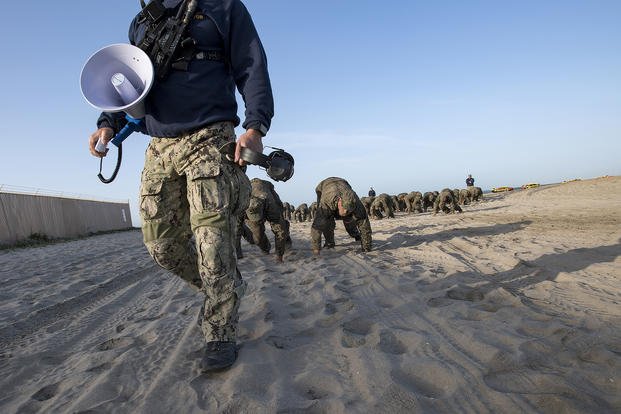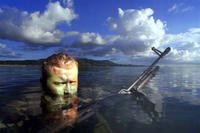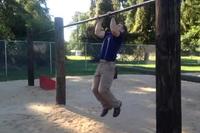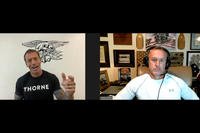Navy SEAL training is extremely demanding, and it is not designed to "get you in shape." You must be in excellent physical condition and pass the physical screening test before you can be considered a SEAL candidate.
For more on how to get and stay in SEAL shape, visit the Military.com Fitness Center.
The following Navy SEAL Physical Screening Test (PST) is designed to see whether you have what it takes to enter SEAL training. To pass, you must complete the following regimen:
| Physical Screening Test | Average Contract | Minimum |
| Swim 500-yard breast or side stroke | 9:30 | 12:30 |
| Push-ups in two minutes | 75 | 50 |
| Sit-ups in two minutes | 75 | 50 |
| Pull-ups no time limit | 15 | 10 |
| Run 1.5 miles* | 9:30 | 10:30 |
The following Navy SEAL PST is designed to see whether you have what it takes to enter SEAL training. To get accepted into the SEAL training pipeline, you must at least meet the minimum standards.
Want to gain a Special Operator (SO) rating contract? Those contracts are only offered to the best scores throughout all the recruiting districts each month. Notice the average contract score above. That means there are some worse, but also many that are much better than this. Do yourself a favor and crush this fitness test so the recruiting staff will take you seriously. That is the test that gets your foot into the door of Naval Special Warfare. Your ability to progress further will be required in the following steps:
The minimum standards will allow you to start training with your Navy SEAL/SWCC Scout Team during your delayed entry program phase. A SEAL Mentor program used in the past no longer exists. You will be tested by a team of trained recruiters for the PST and remaining recruitment process while in the Delayed Entry Program (DEP).
To determine if you're awarded a SEAL/SWCC contract, your PST scores are ranked nationally, and only the best PST scores (average scores or better) fill the needed billets for that boot camp cycle. This program is called the Navy Spec War Draft, and it creates a ranking system of the top scoring athletes who get to go to boot camp as SO candidates. The program's setup gives the SEAL/SWCC candidate more time to train properly before boot camp.
At the Navy Recruit Training Center (Navy boot camp), SEAL candidates start their training with the 10-week Navy boot camp in Great Lakes, Illinois.
Since the BUD/S Prep program that was previously in Great Lakes is now in Coronado, California, you'll next be flown there to start your pre-training in the BUD/S compound. You will take the PST one last time. If you do not pass, you will be dropped from the program before the first week of prep is complete.
BUD/S Prep is a five-week training program followed by a two-week Naval Special Warfare orientation program with immediate assignment to BUD/S (Basic Underwater Demolition/SEAL) training. The goal of BUD/S Prep is to focus on physical fitness and prepare you better for BUD/S physically after getting somewhat deconditioned at boot camp. You will have to take another fitness test at the end of BUD/S Prep before moving forward into the actual first phase of BUD/S training:
| Exercise | Pass to Advance |
| 1,000M swim with fins (sidestroke) | 20 minutes or less |
| Push-ups | 70 or more |
| Curl-ups | 60 or more |
| Pull-ups | 10 or more |
| 4-mile run (with pants and shoes) | 31 minutes or less |
Each week at SEAL training, you will take a two nautical mile (4,000 yards) swim with fins, a four-mile timed run (in boots/pants) and perform an obstacle course, all regardless of the phase of training. You will also take many other tests specific to each phase of training, such as the 50-meter underwater swim, drownproofing test, lifesaving test, underwater knot tying and treading test (with and without fins).
In the Dive Phase (second phase), you will take a wide variety of SCUBA tests (academic and physical). In the Land Warfare Phase (third phase), you will be tested with land navigation tests, rifle and pistol marksmanship, and many other tests varying in physical difficulty and tactical proficiency.
The Navy SEAL Training Program
The Navy SEAL training program will stress you beyond your limits to make sure you're worthy to serve with the world's best fighting force. Be prepared, stay focused, make mature choices and understand what you are volunteering for.
SEAL training prepares you for the extreme physical and mental challenges of SEAL missions. If you're up to the challenge, you'll be in incredible physical shape and possess the confidence, determination and skills needed to succeed in today's combat environment.
Basic Underwater Demolition/SEAL Training
BUD/S is a seven-month training challenge that develops your mental and physical stamina and leadership skills. Each BUD/S phase includes timed physical condition tests, with the time requirements becoming more demanding each week. Talk with your recruiter and discuss the entry physical requirements.
Navy SEAL Pay: Did You Know?
SEALs receive military pay and allowances, plus $375/month dive pay, $300/month special delivery vehicle (SDV) team pay, $225/month HALO (jump) pay, $110/month special duty assignment pay and various amounts per month for second-language proficiency.
Navy SEAL Training BUD/S Phase Descriptions
BUD/S Prep and Orientation: Helps prepare and gives students an introduction to required BUD/S techniques and performances.
First Phase (basic conditioning): Includes continuous physical conditioning. Students also study small boat seamanship.
Second Phase (diving): Covers SCUBA skills. Students learn open and closed circuit combat diving and how to complete long-distance underwater transit dives.
Third Phase (land warfare): Includes land navigation, small-unit tactics, rappelling, military land and underwater explosives and weapons training.
Navy SEAL Training Post-BUD/S
BUD/S graduates will attend SEAL Qualification Training (SQT) immediately after BUD/S. This six-month school is in Coronado, California, and focuses on preparing BUD/S graduates to become members of the SEAL team with advanced training in diving, shooting, parachuting (static and freefall), small unit tactics and mission planning, diving medicine and medical skills training in the Special Operations Medical Course (for medical personnel). Once all courses are completed, graduates are assigned to a SEAL or SDV team for duty.
Advanced Training
Training, physical conditioning and drills are part of the SEAL lifestyle. Once you've completed the BUD/S and SQT SEAL training, you can go even further with advanced training within your team, which includes foreign language training, SEAL tactical communications training, sniper, military free-fall parachuting, jump master, explosive breacher and much more.
Ready to Join the Military?
We can put you in touch with recruiters from the different military branches. Learn about the benefits of serving your country, paying for school, military career paths and more: sign up now and hear from a recruiter near you.












